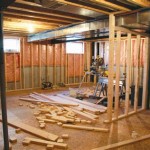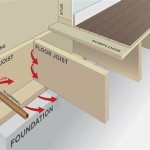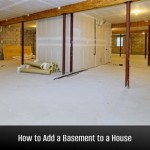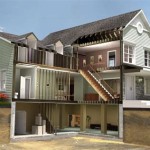Floor Plans for 2-Story Houses with Basements: Maximizing Space and Functionality
The design of a two-story house coupled with a basement offers a significant advantage in terms of living space and functionality. It allows for a larger footprint without necessarily requiring a sprawling lot, and the basement provides an additional level for a wide range of purposes, from recreation and storage to potential living quarters. Developing effective floor plans for such a structure requires careful consideration of the interaction between all three levels and how each contributes to the overall lifestyle of the occupants.
When planning a two-story house with a basement, it’s crucial to understand the potential benefits and challenges associated with each level. The main floor typically accommodates communal areas such as living rooms, kitchens, and dining spaces, as well as potentially a home office or guest bedroom. The second floor usually houses private spaces like bedrooms and bathrooms. The basement presents an opportunity to create specialized areas, such as a home theater, gym, game room, or additional storage.
The structural integrity and code compliance are of paramount importance. Foundations, load-bearing walls, and egress requirements must be meticulously planned and executed. Moreover, the placement of staircases connecting all three levels needs to be strategically considered to ensure ease of access and efficient flow throughout the house. Optimizing natural light, ventilation, and energy efficiency is also vital in creating a comfortable and sustainable living environment.
Key Point 1: Integrating the Basement into the Overall Floor Plan
The basement should not be treated as an afterthought. Instead, it should be intentionally integrated into the overall floor plan to maximize its potential. The functionality of the basement is largely dependent on the homeowner's needs and lifestyle. However, regardless of the specific use, several factors should be considered during the planning phase.
Firstly, think about accessibility. The primary access point to the basement is typically a staircase from the main floor. However, consider adding a secondary access point, such as a walk-out basement entrance, if the terrain allows. A walk-out basement not only provides easier access to the outdoors but also enhances natural light and ventilation, making the space more inviting and versatile. It can also potentially serve as a separate entrance for a rental unit or an in-law suite, adding value to the property.
Secondly, consider the placement of mechanical systems. The basement often houses the HVAC system, water heater, and electrical panel. Proper placement of these systems is essential for ease of maintenance and noise reduction. It's often beneficial to locate these systems in a dedicated utility room to minimize their impact on usable living space. Furthermore, ensure adequate ventilation and insulation around these systems to prevent moisture buildup and energy loss.
Thirdly, address potential moisture issues. Basements are naturally prone to moisture problems, so it's crucial to take preventative measures during the construction phase. Proper waterproofing of the foundation walls, installation of a reliable drainage system, and adequate ventilation are essential to prevent mold growth and water damage. Consider using moisture-resistant materials for flooring and wall finishes to further mitigate the risk of moisture-related problems.
Finally, plan for adequate lighting and ventilation. Basements often lack natural light, so it's essential to incorporate sufficient artificial lighting. Recessed lighting, task lighting, and ambient lighting can be used to create a bright and inviting atmosphere. In addition, ensure proper ventilation to prevent stale air and moisture buildup. Consider installing windows or an air exchanger to improve air quality and circulation.
Key Point 2: Optimizing Space on the Main and Second Floors
The floor plans for the main and second floors should be designed to maximize space and functionality while catering to the specific needs of the occupants. The main floor is typically the hub of the house, so it needs to be designed for both everyday living and entertaining. The second floor typically houses the private spaces, so it needs to be designed for comfort and relaxation.
On the main floor, consider an open concept floor plan for the living room, kitchen, and dining room. Open concept designs promote a sense of spaciousness and facilitate social interaction. However, it's important to define distinct zones within the open space to maintain a sense of order and functionality. This can be achieved through strategic furniture placement, changes in flooring, or the use of architectural elements such as columns or half walls.
The kitchen should be designed with both functionality and aesthetics in mind. The "work triangle," which connects the sink, refrigerator, and stove, should be efficiently arranged to minimize steps and maximize workflow. Consider incorporating ample counter space, storage solutions, and task lighting. A kitchen island can provide additional counter space, seating, and storage, while also serving as a focal point for the room.
On the second floor, the master suite should be designed as a private retreat. This may include a spacious bedroom, a walk-in closet, and a luxurious bathroom. The bathroom should be designed with both functionality and relaxation in mind. Consider incorporating features such as a soaking tub, a separate shower, and double vanities. Natural light and ventilation are also important in creating a comfortable and inviting bathroom.
The secondary bedrooms should be designed with flexibility in mind. Consider the potential needs of future occupants, such as children, guests, or elderly parents. Incorporate ample closet space and ensure that each bedroom has access to a bathroom. A shared bathroom between two bedrooms, often referred to as a "Jack and Jill" bathroom, can be an efficient use of space.
The strategic placement of staircases connecting the main and second floors is also critical. The staircase should be easily accessible from the main living areas and should not obstruct the flow of traffic. Consider the aesthetic impact of the staircase as well. A well-designed staircase can be a focal point of the house, adding architectural interest and visual appeal.
Key Point 3: Structural Considerations and Code Compliance
Developing floor plans for a two-story house with a basement requires careful consideration of structural integrity and code compliance. The foundation, walls, and roof must be designed to withstand the loads imposed by the building and the environment. Moreover, the house must comply with all applicable building codes and regulations, which vary depending on the location.
The foundation is the most critical structural element of the house. It must be designed to support the weight of the house and resist soil pressure. The type of foundation depends on soil conditions and the local climate. Common foundation types include poured concrete walls, concrete block walls, and precast concrete panels. The foundation should be properly waterproofed and drained to prevent moisture problems.
The walls must be designed to resist wind loads, seismic loads, and gravity loads. Load-bearing walls support the weight of the roof and upper floors, while non-load-bearing walls simply divide space. Framing materials commonly used for walls include wood studs, steel studs, and concrete blocks. The walls should be properly insulated to improve energy efficiency and reduce noise transmission.
The roof must be designed to resist wind loads, snow loads, and rain. The roof framing typically consists of rafters or trusses that support the roof covering. Common roof covering materials include asphalt shingles, metal roofing, and tile roofing. The roof should be properly ventilated to prevent moisture buildup and extend the life of the roofing materials.
Egress requirements are a critical aspect of code compliance. Each habitable space in the house must have at least one means of egress to the outside. This typically consists of a door or window that can be easily opened in an emergency. The basement must have a means of egress that meets specific requirements, such as a walk-out door or an egress window well. Staircases must also comply with specific code requirements for tread depth, riser height, and handrails.
Finally, ensure compliance with all applicable fire safety codes. This includes the installation of smoke detectors in each bedroom and on each floor, as well as the installation of carbon monoxide detectors near sleeping areas. Fire-resistant construction materials may also be required in certain areas of the house, such as around the furnace and water heater.
The successful creation of floor plans for a two-story house with a basement depends on a thorough understanding of how to integrate each level, optimize space efficiently, and adhere to all structural and code requirements. This process underscores the importance of collaborating with experienced architects, engineers, and contractors to ensure a safe, functional, and aesthetically pleasing final result.

Stylish And Smart 2 Story House Plans With Basements Houseplans Blog Com

Stylish And Smart 2 Story House Plans With Basements Houseplans Blog Com

2 Story House Floor Plans 6 Bedroom Craftsman Home Design With Basement

Stylish And Smart 2 Story House Plans With Basements Houseplans Blog Com

House Design Plan 13x12m With 5 Bedrooms Home Layout Plans Blueprints Sims

2 Story 4 Bedroom Layout

Modern 2 Story Home Plan With Basement 267002spk Architectural Designs House Plans

Best Two Story House Plans And Floor Drummondhouseplans

Stylish And Smart 2 Story House Plans With Basements Houseplans Blog Com

Affordable Bluegrass Valley House Plan Archival Designs
Related Posts







